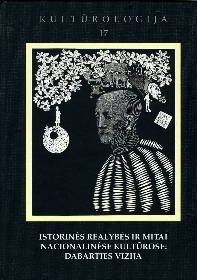Perforežisūra: „Hamleto“ atvejis
Performance Direction: Hamlet Case
Author(s): Rasa VasinauskaitėSubject(s): Cultural Essay, Political Essay, Societal Essay
Published by: Lietuvos kultūros tyrimų
Keywords: drama text; performance; direction; scenic text; histrionic text; theater
Summary/Abstract: Many Western and USA theater critics in the sixties – nineties of the XX c. notice a significant shift in contemporary drama theater practice from verbal to non-verbal expression and tend to outline this period as changes on the grounds of avantgarde and experimental theater experiences. It is characteristic of the latter to use physical or bodily expression and immediate performance entity presuposed by this physicality. After the premiere of Eimuntas Nekrošius’ “Hamlet” in 1997 there were nearly no talks about performativity of the play. Both Lithuanian and foreign critics analyzed Nekrošius performance only from the positions of author’s interpretation stressing its especially suggestive visuality and physicality. While analyzing the spectacle from the positions of performativity the authoress of the article draws the attention at the functionality of the “Hamlet” scenic view, the physicality of acting as immediate performance entity, the particularity and materiality of the scenic images. It is accentuated that Hamlet playing Andrius Mamontovas, a rock singer occupying a certain place in socio – cultural space, in the system of the spectacle executes not only “actor’s” but, also, “performer’s” function. In her comparison of Nekrošius and the spectacles directed by young foreign artistic directors the authoress arrives at a conclusion: these are theaters of unidentical artistic systems created by directors of different generations and with different experiences. Differences are seen not as much in the choice of performative practices rather then in artists enunciation strategies: Lithuanian director preserved the component of authorial interpretation presuposed by understanding of the spectacle as a self-sufficient aesthetical object and spectacle performativity here is indistinguishable from the concretisation of Shakespeare’s tragedy. Thus, on the one hand, the authoress evaluates Nekrošius’ “Hamlet” as these times director’s attitude towards the quintessence of existing social and artistic context where namely because of mise-en-scène performativity obtains aesthetic meaning; and on the other hand – as a scenic concreatisation which with the help of histrionic text expands the limits of drama text. occupying a certain place in socio – cultural space, in the system of the spectacle executes not only “actor’s” but, also, “performer’s” function. In her comparison of Nekrošius and the spectacles directed by young foreign artistic directors the authoress arrives at a conclusion: these are theaters of unidentical artistic systems created by directors of different generations and with different experiences...
Journal: Kultūrologija
- Issue Year: 2009
- Issue No: 17
- Page Range: 180-201
- Page Count: 21
- Language: Lithuanian

